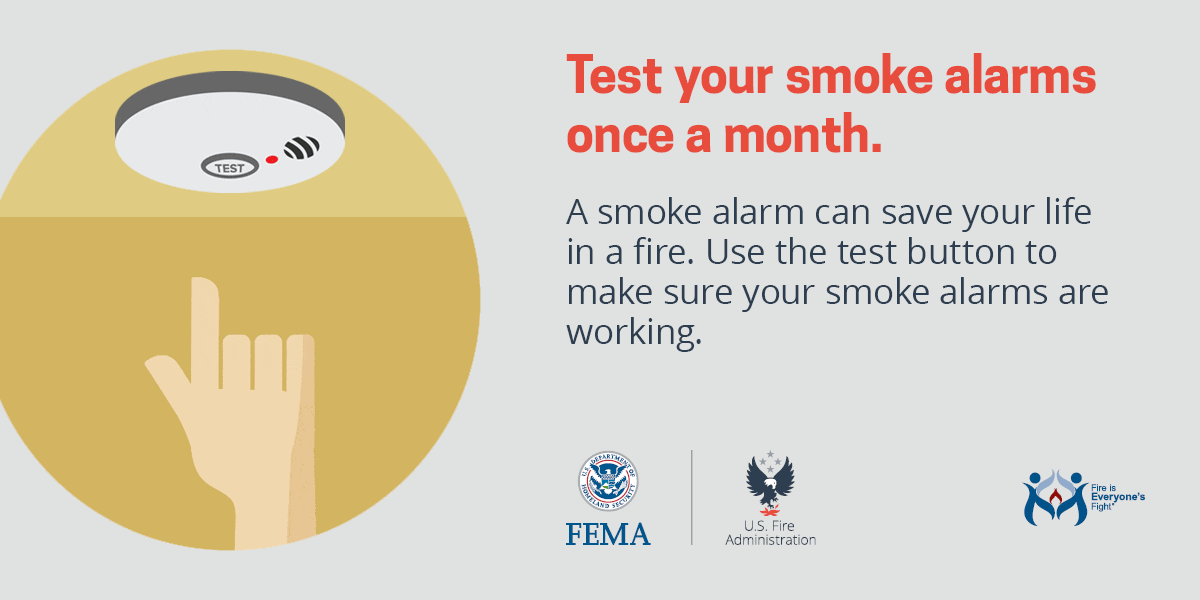Installing smoke alarms in every bedroom, outside each separate sleeping area, and on every level of a home — including the basement — is a fire safety precaution that all homeowners and landlords in your community need to take to protect residents from fire.
Did you know:
Age matters when it comes to smoke alarms. They need to be replaced 10 years from the manufacture date.
Answers to common questions about smoke alarms
What types of smoke alarms can I buy?
There are many brands of smoke alarms on the market, but they fall under 2 basic types: ionization and photoelectric.
Ionization and photoelectric smoke alarms detect different types of fires. Since no one can predict what type of fire might start in their home, the U.S. Fire Administration recommends that every home and place where people sleep have:
- Both ionization AND photoelectric smoke alarms, OR
- Dual-sensor smoke alarms, which contain both ionization and photoelectric smoke sensors.
Choose interconnected smoke alarms so that when one sounds, they all sound.
There are also alarms for people with hearing loss. These alarms may have strobe lights that flash and/or vibrate to alert those who are unable to hear standard smoke alarms when they sound.
Smoke alarms are not expensive and are worth the lives they can help save.
Alarm type and cost
- Ionization and photoelectric: $6 and up
- Dual-sensor: $24 and up
- Smoke alarms with a microprocessor (faster to alert, fewer false alarms): $30 and up
- Radio frequency/wireless (communicate from one to the next without wires): $40 and up
Some fire departments offer reduced-price, or even free, smoke alarms. Contact your local fire department's nonemergency phone number for more information.
Your city, county or state may require a specific type of alarm. Please check with your local fire marshal for information on what type of alarm you need.
Smoke alarms are powered by battery or by your home's electrical system. If the smoke alarm is powered by battery, it runs on either a disposable 9-volt battery or a nonreplaceable 10-year lithium-ion (“long-life”) battery. Alarms that get power from your home's electrical system, or “hardwired” alarms, usually have a backup battery that will need to be replaced once a year.
Where do I put smoke alarms in my home?
- Put smoke alarms inside and outside each bedroom and sleeping area. A closed door may slow the spread of smoke, heat and fire.
- Put alarms on every level of the home. Smoke alarms should be interconnected. When one sounds, they all sound.
- Put smoke alarms on the ceiling or high on the wall. Check the manufacturer's instructions for the best place for your alarm.
- Only qualified electricians should install hardwired smoke alarms.
Some fire departments will install battery-operated smoke alarms in your home at no cost. Contact your local fire department's nonemergency phone number for more information.
How do I take care of my smoke alarm?
Is your smoke alarm still working? A smoke alarm with a dead or missing battery is the same as having no smoke alarm at all. A smoke alarm only works when it is properly installed and regularly tested. Take care of your smoke alarms according to the manufacturer's instructions. Below are some general maintenance tips.
Smoke alarm powered by a 9-volt battery
- Test the alarm monthly.
- Replace the batteries at least once every year.
- Replace the entire smoke alarm every 10 years.
Smoke alarm powered by a 10-year lithium-ion (or “long-life”) battery
- Test the alarm monthly.
- Replace the entire smoke alarm according to the manufacturer's instructions.
Smoke alarm that is hardwired into your home's electrical system
- Test the alarm monthly.
- Replace the backup battery at least once every year.
- Replace the entire smoke alarm every 10 years.
What should I do if my smoke alarm sounds while I'm cooking?
Never take the battery out of your smoke alarm while cooking! If a smoke alarm sounds while you're cooking or taking a shower with lots of steam, do not remove the battery. You should:
- Open a window or door and press the “hush” button.
- Wave a towel at the alarm to clear the air.
- Move the entire alarm several feet away from the kitchen or bathroom.
Disabling a smoke alarm or removing the battery can be a deadly mistake.
Messages to share
Social media graphics and stock photos

Pictographs
Pictographs can help overcome literacy barriers by communicating messages with pictures. Our pictographs will help you to communicate smoke alarm messages to high-risk populations.



Handouts
Video
https://youtu.be/94sZZgYDqWA
https://youtu.be/r-P46y5JFxc


